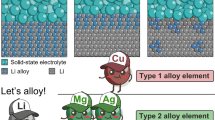Abstract
Li2ZrCl6 with a trigonal structure is a low-cost Li+-conducting chloride electrolyte, which is stable at high voltages up to 4.2 V and is compatible with high-voltage cathodes. However, its relatively low room-temperature ionic conductivity, poor stability in different solvents and at high temperatures limit its application for next-generation all-solid-state batteries. Herein, we prepared new oxychloride electrolytes with different molar ratios of Li2O, ZrCl4, and LiCl, replacing Cl− with O2− anion to optimize the electrolyte performance. The results showed that increasing the Li2O content reduced the crystallization degree of trigonal Li2ZrCl6 and induced a monoclinic structure in the prepared oxychloride electrolyte. The oxychloride with the general formula Li2.22Zr1.11Cl5.33O0.67 had a high room-temperature ionic conductivity above 10−3 S cm−1. Moreover, introducing Li2O considerably increased the thermal and solvent stability of the electrolyte. Good ionic conductivity and stability of the electrolyte enable the stable cycling of all-solid-state Li-In/LiCoO2 batteries.

摘要
成本低廉的锂离子导体氯化物固态电解质Li2ZrCl6, 属于三方晶系, 可在4.2 V下保持稳定, 与高压正极材料具有良好的兼容性. 然而,相对较低的室温离子电导率、较差的化学稳定性和热稳定性等缺点阻碍了它在全固态电池中的进一步发展. 基于此, 我们利用Li2O, ZrCl 4 和LiCl合成了新型氧氯化物固态电解质, 并通过O2−对Cl−的取代来优化固态电解质的性能. 结果表明增加Li2O的含量会降低三方相Li2ZrCl 6 的结晶度, 且诱导单斜结构的产生. 新合成的Li2.22Zr1.11Cl5.33O0.67 室温电导率可到10−3S cm−1. 此外, Li2O的加入能够提高固态电解质的热稳定性和溶剂稳定性. 固态电解质Li2.22Zr1.11Cl5.33O0.67 良好的离子电导率及稳定性使得Li-In/LiCoO2 全固态电池具有稳定的循环性能.
Similar content being viewed by others
References
Banerjee A, Wang X, Fang C, et al. Interfaces and interphases in all-solid-state batteries with inorganic solid electrolytes. Chem Rev, 2020, 120: 6878–6933
Li X, Liang J, Yang X, et al. Progress and perspectives on halide lithium conductors for all-solid-state lithium batteries. Energy Environ Sci, 2020, 13: 1429–1461
Wang C, Liang J, Kim JT, et al. Prospects of halide-based all-solid-state batteries: From material design to practical application. Sci Adv, 2022, 8: eadc9516
Kwak H, Wang S, Park J, et al. Emerging halide superionic conductors for all-solid-state batteries: Design, synthesis, and practical applications. ACS Energy Lett, 2022, 7: 1776–1805
Miao X, Guan S, Ma C, et al. Role of interfaces in solid-state batteries. Adv Mater, 2023, 2206402
Wang C, Fu K, Kammampata SP, et al. Garnet-type solid-state electrolytes: Materials, interfaces, and batteries. Chem Rev, 2020, 120: 4257–4300
Li Y, Xu B, Xu H, et al. Hybrid polymer/garnet electrolyte with a small interfacial resistance for lithium-ion batteries. Angew Chem Int Ed, 2017, 56: 753–756
Li Y, Han JT, Wang CA, et al. Optimizing Li+ conductivity in a garnet framework. J Mater Chem, 2012, 22: 15357–15361
Zhao Q, Stalin S, Zhao CZ, et al. Designing solid-state electrolytes for safe, energy-dense batteries. Nat Rev Mater, 2020, 5: 229–252
Schlem R, Muy S, Prinz N, et al. Mechanochemical synthesis: A tool to tune cation site disorder and ionic transport properties of Li3MCl6 (M = Y, Er) superionic conductors. Adv Energy Mater, 2020, 10: 1903719
Wang S, Bai Q, Nolan AM, et al. Lithium chlorides and bromides as promising solid-state chemistries for fast ion conductors with good electrochemical stability. Angew Chem Int Ed, 2019, 58: 8039–8043
Sebti E, Evans HA, Chen H, et al. Stacking faults assist lithium-ion conduction in a halide-based superionic conductor. J Am Chem Soc, 2022, 144: 5795–5811
Asano T, Sakai A, Ouchi S, et al. Solid halide electrolytes with high lithium-ion conductivity for application in 4 V class bulk-type all-solidstate batteries. Adv Mater, 2018, 30: 1803075
Kageyama H, Hayashi K, Maeda K, et al. Expanding frontiers in materials chemistry and physics with multiple anions. Nat Commun, 2018, 9: 772
Li X, Liang J, Chen N, et al. Water-mediated synthesis of a superionic halide solid electrolyte. Angew Chem Int Ed, 2019, 58: 16427–16432
Wang K, Ren Q, Gu Z, et al. A cost-effective and humidity-tolerant chloride solid electrolyte for lithium batteries. Nat Commun, 2021, 12: 4410
Kwak H, Han D, Lyoo J, et al. New cost-effective halide solid electrolytes for all-solid-state batteries: Mechanochemically prepared Fe3+-substituted Li2ZrCl6. Adv Energy Mater, 2021, 11: 2003190
Gautam A, Sadowski M, Prinz N, et al. Rapid crystallization and kinetic freezing of site-disorder in the lithium superionic argyrodite Li6PS5Br. Chem Mater, 2019, 31: 10178–10185
Wang S, Fang R, Li Y, et al. Interfacial challenges for all-solid-state batteries based on sulfide solid electrolytes. J Materiomics, 2021, 7: 209–218
Schlem R, Banik A, Ohno S, et al. Insights into the lithium substructure of superionic conductors Li3YCl6 and Li3YBr6. Chem Mater, 2021, 33: 327–337
Zhou L, Zuo TT, Kwok CY, et al. High areal capacity, long cycle life 4 V ceramic all-solid-state Li-ion batteries enabled by chloride solid electrolytes. Nat Energy, 2022, 7: 83–93
Shao Q, Yan C, Gao M, et al. New insights into the effects of Zr substitution and carbon additive on Li3−xEr1−xZrxCl6 halide solid electrolytes. ACS Appl Mater Interfaces, 2022, 14: 8095–8105
Zhou L, Kwok CY, Shyamsunder A, et al. A new halospinel superionic conductor for high-voltage all solid state lithium batteries. Energy Environ Sci, 2020, 13: 2056–2063
Nikodimos Y, Huang CJ, Taklu BW, et al. Chemical stability of sulfide solid-state electrolytes: Stability toward humid air and compatibility with solvents and binders. Energy Environ Sci, 2022, 15: 991–1033
Acknowledgements
This work was supported by the National Natural Science Foundation of China (22025507 and 21931012), the Key Research Program of Frontier Sciences, Chinese Academy of Sciences (ZDBS-LYSLH020), and Beijing National Laboratory for Molecular Sciences (BNLMS-CXXM-202010).
Author information
Authors and Affiliations
Contributions
Cao AM and Li Y designed the samples; Li B and Wu TT performed the experiments; Li B, Zhang HS and Guo S performed the data analysis; Li B and Li Y wrote the paper with support from Cao AM. All authors contributed to the general discussion.
Corresponding authors
Additional information
Conflict of interest
The authors declare that they have no conflict of interest.
Supplementary information
Experimental details and supporting data are available in the online version of the paper.
Bing Li is pursuing her doctor degree at the Key Laboratory of Molecular Nanostructure and Nanotechnology, Institute of Chemistry, Chinese Academy of Sciences (ICCAS). She received her Master degree from Zhengzhou University. Her research interest focuses on designing solid-state oxychloride electrolytes and optimizing the interface for all-solid-state batteries.
Yutao Li received his PhD degree in materials science and engineering from Tsinghua University in 2013. He joined Prof. John B. Goodenough’s group to develop new materials for next-generation solid-state batteries at the University of Texas, Austin from 2013 to 2022. He is currently an associate professor at the Institute of Physics, CAS. His research focuses on developing fast ionic conductors and optimizing the interface for all-solid-state batteries.
An-Min Cao earned his PhD degree from the ICCAS in 2006. Thereafter he did postdoctoral research in Prof. Götz Veser’s group on functional nanomaterials for heterogeneous catalytic reactions. In May 2010, he transferred to the University of Texas, Austin to work on clean energy-related materials with Prof. A. Manthiram. He has served as a full professor at the ICCAS since 2012. His current research centers on the surface/interface control of high-energy electrode materials for secondary batteries.
Supplementary Information
Rights and permissions
About this article
Cite this article
Li, B., Li, Y., Zhang, HS. et al. Fast Li+-conducting Zr4+-based oxychloride electrolyte with good thermal and solvent stability. Sci. China Mater. 66, 3123–3128 (2023). https://doi.org/10.1007/s40843-023-2434-4
Received:
Accepted:
Published:
Issue Date:
DOI: https://doi.org/10.1007/s40843-023-2434-4




